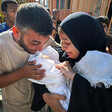Rights and Accountability 27 April 2018

Palestinians protest east of Bureij in central Gaza on 27 April.
APA imagesFour Palestinians were fatally wounded during the fifth consecutive Friday of mass protests as part of the Great March of Return demonstrations along Gaza’s eastern boundary with Israel.
Nearly 1,000 were injured during Friday’s protest, nearly 200 of them by live fire, according to Gaza’s health ministry.Eleven were reported to be seriously injured.
The health ministry announced on Saturday that Azzam Oweida, 15, died from his injuries sustained during protests east of Khan Younis in southern Gaza a day earlier. He is the fifth child to be killed during the Great March of Return protests since their launch on 30 March.
Abd al-Salam Eid Zuhdi Baker, 33, was shot in the stomach, also east of Khan Younis.
Two Palestinians were killed east of Gaza City, where Palestinians defied Israel’s shoot-to-kill-and-maim policy and placed their national flag on the boundary fence:
The two slain men were identified as Khalil Naim Mustafa Atallah, 22, from Gaza City and Muhammad Amin Ahmad al-Muqid, 21, from Beach refugee camp. Al-Muqid was wounded by a live bullet to his head and Atallah was injured by shrapnel.Israel claimed that its forces “operated in accordance with the rules of engagement and thwarted the attempted infiltration” by “rioters” who “approached the security fence, hurled rocks and firebombs, and tried to light the fence on fire.”
The New York Times, citing four unnamed witnesses, said that two Palestinians with handguns opened fire during the incident. Two other witnesses denied to the paper that anyone fired a gun toward the Israelis.
The Israeli military published its own video of the incident, showing protesters approaching the boundary fence as a military jeep fires on them from the other side:
The video does not appear show, and the Israeli military did not claim, any Palestinian had a gun.None of the videos and photos from Friday’s protests seen by The Electronic Intifada indicate that any participants were armed with guns.
The Gaza-based Palestinian Center for Human Rights stated that its researchers did not see any militants or armed protesters in civilian clothes during Friday’s protests.
The Israeli government has justified the use of lethal force against the Great March of Return by saying that protesters are “trying to infiltrate into Israel, damage our infrastructure and kill Israelis,” as a military spokesperson told The New York Times on Friday.
In order to support that narrative, an Israeli government spokesperson tweeted a video on Friday which he falsely claimed showed a Palestinian girl saying of Israelis, “we want to kill them.” As Arabic speakers pointed out, the girl in the video did not say those words.
Israel bombed multiple sites across Gaza on Friday night, claiming that it was in response to “extensive attempts to breach Israeli territory” earlier in the day.
With Israel under growing criticism for its policy of shooting unarmed protesters, the bombing may have been an effort to provoke Hamas or other resistance factions into a military response, thereby making it easier from Israel’s propaganda perspective to justify its use of violence.Thirty-nine Palestinians, including five children and two journalists, have been fatally wounded by Israeli forces during the Great March of Return protests.
On Friday, the office of the United Nations High Commissioner for Human Rights stated that Israeli forces, “in policing the Gaza fence,” may only “resort to lethal force in cases of extreme necessity, as a last resort in response to an imminent threat of death or risk of serious injury.”
The human rights body added: “It is difficult to see how tire-burning or stone-throwing, or even Molotov-cocktails thrown from a significant distance at heavily protected security forces in defensive positions can be seen to constitute such threat.”
No Israelis have been reported injured as a result of the protests, and not a single rocket has been fired from Gaza since the demonstrations were launched on 30 March.Seven journalists and five paramedics were reported injured during Friday’s protest.
Photojournalist and cameraman Abd al-Rahman al-Kahlout, 24, was shot by a live bullet in his right leg while wearing a bulletproof vest marked as “PRESS” and a helmet marked “TV,” according to the Committee to Protect Journalists. Photos published on social media show an injured al-Kahlout wearing protective gear identifying him as a member of the press:
Two journalists were hit in the head with tear gas canisters, according to the press freedom watchdog. Other journalists were injured by tear gas inhalation.Paramedic Mazen Jibril Hasna, 32, was hit by a live bullet in his legs while transporting wounded protesters east of Gaza City, and Israeli forces twice fired tear gas at a field clinic east of al-Bureij in central Gaza:
Protester Hatem Abd al-Latif al-Talbani, 20, was in critical condition after he was hit by a gas bomb directly below his left eye during the protest east of al-Bureij.Graphic photos that circulated on social media show the weapon embedded in al-Talbani’s face.
The Gaza health ministry published a photo of the weapon after it was removed from al-Talbani’s face, explaining that the the black part of it was lodged underneath the youth’s eye.
The Great March of Return protests against Israel’s siege, and in support of Palestinian refugees’ right to return to the lands from which their families were expelled during the establishment of the state of Israel in 1948, were set to culminate on 15 May, when Palestinians mark the dispossession of their homeland.
But Hamas chief Ismail Haniyeh reportedly stated on Wednesday that the protests would continue during the month of Ramadan, which begins in mid-May.
“The Palestinian people will demonstrate throughout the month of Ramadan to deal with the many challenges facing us, and first of all the peace plan promoted by US President Donald Trump, called the ‘Deal of the Century,’” the Israeli daily Haaretz quoted Haniyeh as saying.
Haniyeh visited the Great March of Return protest camp in Rafah, southern Gaza, on Friday, stating: “We will not retreat from the marches which have confused the occupier, and he will reconsider his calculations towards these marches which are putting us on the road to liberation.”
He saluted protesters using burning tires, large slingshots and kites with burning materials tied to them which “terrifies the occupier, so what would you say to rockets and bombs if they were launched?”
Yahya Sinwar, the head of Hamas in Gaza, paid tribute to paramedics when he visited a field tent in Khan Younis, southern Gaza, on Friday. He stated that “liberation and return are very near.”This story was updated on 28 April after the announcement of Azzam Oweida’s death.






Comments
handala is watching...
Permalink handala replied on
The people of gaza are illegally caged by an occupying military force. Back in 48 a group of people(mostly them illegal immigrants) declared themselves a country on the majority of the land which they had no right to do. Violence ensued, many people fled the violence and when the violence was over, they simply wanted to go home. That is the reality. The people inside this cage want to go home, which they have a human,universally-recognized right to. That is what this protest is about.